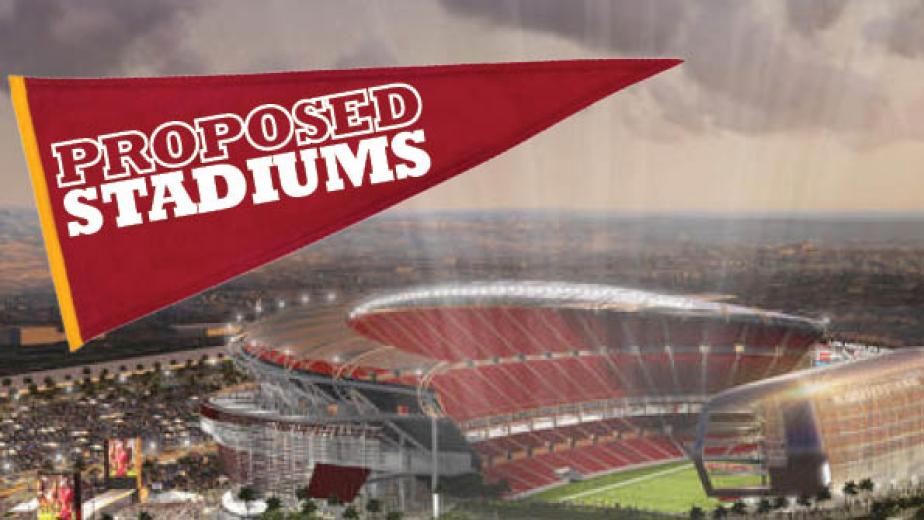1 10
1 10
Proposed by St. Louis Rams' owner Stan Kroenke and his partners, this stadium proposal has already caused controversy. After being approved by the Los Angeles City Council, sports industry competitor AEG hired former Homeland Security Secretary Tom Ridge to produce a report citing the proposed stadium as a safety risk and potential terrorist target due to its position on Los Angeles International Airport's flight path. In addition, the National Transportation Safety Board has claimed the stadium could be victim to landing accidents and falling debris from airplanes overhead--criticisms that the Federal Aviation Authority has dismissed as unfounded. This 80,000-seat stadium has been estimated by various media reports to cost from $1.5 billion to $1.86 billion. It would be built on the former Hollywood Park horse-racing grounds, and feature a clear, retractable roof, allowing it to host basketball games as well as be home to two football teams. Covering 283 acres, the stadium would be the anchor to a newly created sports and entertainment district featuring a 6,000-seat theater, a large open-air shopping center, six to seven office buildings, 2,500 homes and a man-made lake.
Numerous proposals have been made by the San Diego Stadium Coalition to replace Qualcomm Stadium, but none have come to fruition. The most viable plan, to build a stadium downtown in the East Village, expanding the convention center, hangs in limbo due to lack of funds from the NFL G3 Program and the fact that California Gov. Jerry Brown is reviewing the state's redevelopment plans. If San Diego doesn't come up with a new home for the Chargers, the team will return to Los Angeles, from whence it came back in 1961.
The San Diego Chargers and Oakland Raiders have joined forces to propose a shared stadium in Carson, Calif. The $1.7 billion stadium would hold 68,000 seats, expandable to 72,000 seats, and those seats would be clear plastic, reflecting lights programmed to project the Raiders' black and silver colors or the Chargers' powder blue. Sited on 168 acres, the stadium would also feature 18,000 parking spaces and ample room for tailgating.
Numerous proposals have been submitted for the Buffalo Bills. The biggest one, Outer Harbor Stadium, was proposed by Greater Buffalo Sports and Entertainment Complex as a $1.4 billion, 72,000-seat stadium with a retractable roof, convention center, hotel and sports museum. Eventually the price was upped to $1.8 billion, but because four bridges would have to be built to accommodate the resulting increase in traffic, the plan was abandoned in August 214. Currently, a proposal for Olympia Sports Park, located slightly south of the Outer Harbor site, is being considered.
Just this week, this proposal by AEG was abandoned. What it would have accomplished was a replacement of the West Hall of the Los Angeles Convention Center, at a cost of $1.5 billion. In fact, AEG already spent $50 million on the proposal alone. But while AEG has taken the proposal off the table, the company is doing all it can to keep its rival proposal, the joint St. Louis Rams and San Diego Chargers stadium proposed for Inglewood, out of the running. According to reports commissioned by AEG, the Inglewood stadium carries a number of risks due to its positioning in the midst of the flight path from LAX.
If the San Francisco Giants rescind their territorial rights to San Jose or 28 members of the MLB vote yes, this stadium will become the new home for the Oakland Athletics. Cisco Field is to be built on only 12 to 14 acres of available land, creating a very intimate and hitter-friendly stadium. With 32,000 seats planned, Cisco Field's price tag is $462 million.
Last December, the Washington, D.C. City Council unanimously approved this stadium's proposal. Akridge Property will construct the 20,000 to 25,000-seat stadium, costing $180 million to $185 million, on unused land overlooking National Park, home to the Washington Nationals baseball team, at Buzzard Point.
Major League Soccer would bring a team to Miami provided a stadium can be built, but so far no plans have been approved for the necessary 25,000-seat facility. Soccer star David Beckham is leading the charge but hasn't had much of a reception; in fact, one city official told the media that Miami could've been nicer to Beckham, and he's personally apologized to him for the city's bad treatment.
NYC FC soccer club plans to build a 28,000-seat stadium in one of the five boroughs, possibly the Bronx. Mayor Bloomberg had made a deal with the club for a $340 million stadium adjacent to Yankee Stadium, to be built over nine acres, but Mayor de Blasio has expressed doubts because the stadium was to involve several tax breaks and would require the demolishing of a parking garage, with New York City assuming its $240 million debt, plus the demolishing of a factory which would require rebuilding elsewhere. If the stadium does go through, it will be the largest soccer-specific stadium in North America. In the meantime, NYC FC plans to play in Yankee Stadium.

